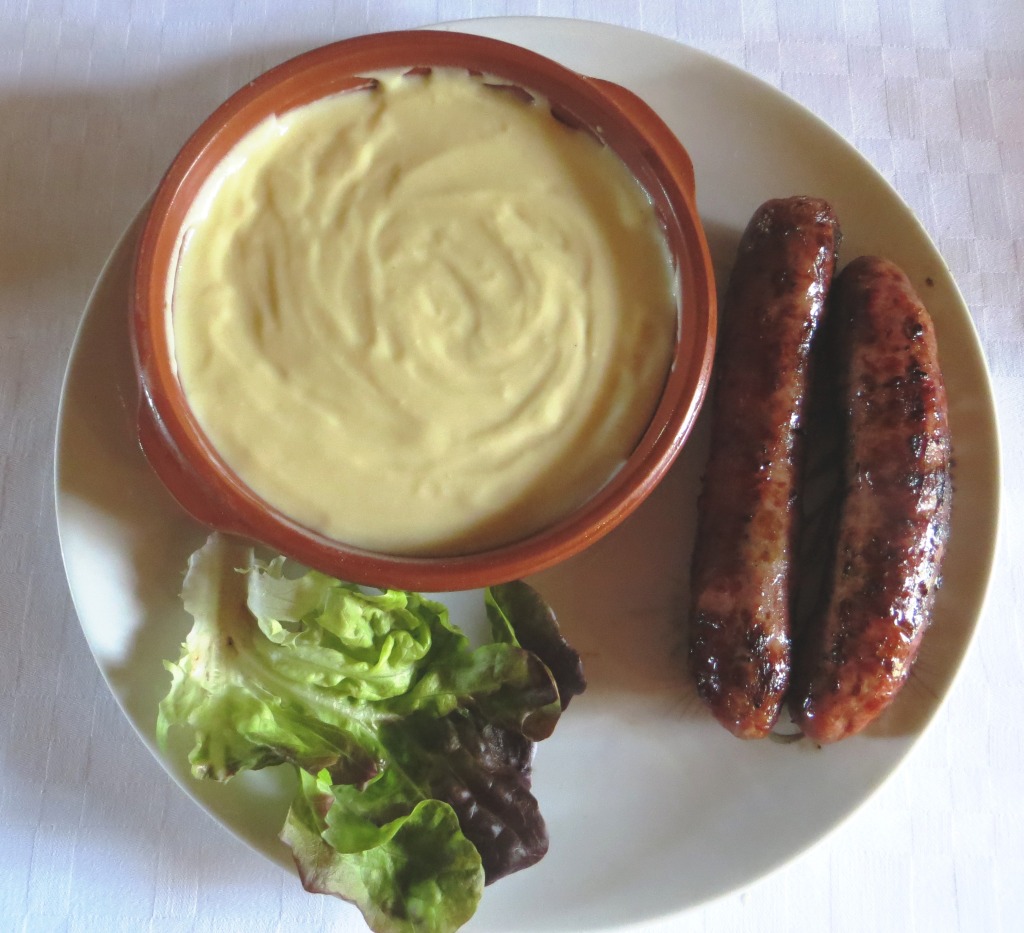
The temperature was approaching -10C when I went downstairs this morning – outside, I hasten to add. This is the coldest spell we’ve had for five years. In this weather you want rib-sticking food; nouvelle cuisine doesn’t hit the spot. What better way to start my series about French dishes than with a look at one that warms you from the inside out: aligot?
What is aligot? It’s basically a thick, unctuous potato and cheese purée that accompanies meats of various descriptions. The main ingredients are potatoes, garlic and tome fraîche, young Laguiole cheese. The dish comes from the mountainous country of the Aubrac, which covers several départements, including Aveyron.
A long history
Aligot is said to have originated in the monasteries of the Aubrac during the 12th century. Then, it was made with broth, bread and tome fraîche. The monks served it to pilgrims travelling the route de Saint-Jacques de Compostelle.
This gave rise to one of the possible origins of the name: the pilgrims would ask for “aliquid”, something to eat. It could also derive from the verb haligoter, which means to tear into strips. The latter is plausible, since the mixture is beaten until it forms long ribbons.
A legend puts aligot’s origins as far back as the 6th century AD. Three bishops of adjacent dioceses met in the midst of the Aubrac, each of them bringing one of the soup’s main ingredients. They left the recipe for posterity. The ‘Three Bishops’ Cross’ now stands at the junction of Aveyron, Cantal and Lozère.
This soup was adopted by local farmers, who replaced the bread with potatoes during a series of bad wheat harvests in the 19th century. Aligot’s popularity was spread during the 20th century by Auvergnat and Aveyronnais restaurateurs in Paris, who retained strong links to their regions of origin.
Big cheeses

Formerly, Laguiole cheese was made on the hillsides by herdsmen who lived during the summer months in stone burons while their cattle grazed the lush pastures. The buronniers were employees who were not supposed to eat the cheese, but kept back a bit of tome fraîche to make aligot.
Tome fraîche is the first stage in the manufacture of Laguiole cheese. It is made from unpasteurised whole milk from the Aubrac race of cows. This unsalted cheese is best for making aligot when it’s between two and 10 days old.
Convivial dish

You can make aligot at home or buy it ready-made, but it’s best in large quantities. It’s nicknamed ‘le ruban de l’amitié’ (lit. the ribbon of friendship), since there’s a certain theatricality in its preparation when it is stretched into long ribbons.
You often find it served at fêtes, traditionally with sausages, but also with other meats. We have enjoyed it on numerous occasions, notably during a visit to the annual transhumance celebrations in the Aubrac itself. A little goes a long way.
Aligot Recipe
For 4 greedy people
1 kg potatoes
400 g tome fraîche
250 g crème fraîche
100 g butter
Several cloves garlic, finely chopped
Salt and pepper to taste
Boil the potatoes and mash them to a purée. Add the butter and crème fraîche and season with salt, pepper and garlic. Reheat the purée. Add the cheese, cut in thin slices. Stir vigorously with a wooden spoon (very important, must be wooden). When the mixture starts to form long ribbons (filer), it’s ready. Serve immediately.
You can use any left over aligot for fried potato cakes.
This post is taking part in the March 2017 #AllAboutFrance linky, where you can read fascinating posts about French life, travel, culture, food and manners.
You might also like:
A Cut Above the Rest: Laguiole Knives
A Brief History of Cheese
Goose Fat and Garlic
Copyright © 2017 Life on La Lune, all rights reserved

[…] French Flavours #1: A is for Aligot […]
LikeLike
[…] French Flavours #1: A is for Aligot […]
LikeLike
[…] French Flavours: A is for Aligot […]
LikeLike
I’ve enjoyed Aligot in the Cevennes. Not sure if it was made with the correct cheese, but I had my French characters enjoying it in my debut novel.
LikeLiked by 1 person
It originated in the Aubrac, so not a million miles from the Cévennes. In that case, I expect they did use the right cheese. I love including food in my novels! Interesting to hear that you have also used this dish in fiction.
LikeLiked by 1 person
I don’t think I’ve ever tasted the real aligot, with Laguiole cheese, but I’m really looking forward to it now. Yum!
#AllAboutFrance
LikeLiked by 1 person
I love it, but it’s not a light dish, so make sure you are hungry!
LikeLike
[…] A Moo-ving Experience: la Fête de la Transhumance Bouquet of Barbed Wire French Flavours: A is for Aligot […]
LikeLike
Oooh looking forward to reading the series…and good luck with X!!! I’ve eaten aligot a couple of times and loved it (both times in Auvergne), perfect comfort food for cold weather… Thanks for linking up to #AllAboutFrance
LikeLiked by 1 person
I hope you enjoy the series. I’ve got to C now – this post was written a few weeks ago. I love aligot. They serve it a lot around here during summer fetes.
LikeLike
[…] Goose Fat and Garlic Garlic and Garlic Recipes French Flavours #1: A is for Aligot […]
LikeLike
My mouth was watering while reading this post. Aligot looks and sounds delicious (more when paired with sausage). I am looking forward to try this! #AllAboutFrance
LikeLiked by 1 person
It’s certainly a mouth-watering dish! I could eat it on its own, but it does make an excellent accompaniment to sausage, or indeed to most meats. I hope you enjoy it.
LikeLike
Thank you for sharing not only the history behind Aligot – I had no idea what the ingredients were. Love your plan to document France through the food from A-Z. #AllAboutFrance
LikeLiked by 1 person
Nice, simple ingredients, although the technique itself is not so easy. You need to have a strong forearm! I’m trying to focus mainly on dishes from SW France, but I expect I will include some from other regions.
LikeLike
Delicious – anything with melted cheese gets my vote. Pure comfort food at it’s best.
LikeLiked by 1 person
I am very partial to it, but eat it only sparingly. A lady sells it in our local market and I have to look the other way as I go past!
LikeLike
Oh yummy. Tickly tastebuds. I could live on aligot. I’m waiting for the fat-free, low-carb and calorie-free version. 🙂
LikeLiked by 1 person
I could live on it, too. And it’s ideal for my husband, for whom a life without potatoes would be a life not worth living. But, yes, the calories and the cholesterol!
LikeLike
Yummy – I love aligot! Great to read about its origins and to have a recipe!
LikeLiked by 1 person
The most difficult part of making it seems to be the beating of it until it forms ribbons. You have to have pretty good muscles for that. Useful as post-Christmas exercise, though…
LikeLiked by 1 person
Have you seen the arms of the guys who make this in the markets, with the enormous wooden paddles!!?? I wonder if a food mixer with the paddle attachment could be enlisted for that task?? 🙂
LikeLiked by 1 person
Yes, they are pretty hefty. I’m sure purists would say that only a human arm will do the job and not a food mixer!
LikeLiked by 1 person
🙂
LikeLike
Probably in the top 10 of things I miss from home…
LikeLiked by 1 person
I had to come and live in France to discover aligot, but I’d miss it too, if I left.
LikeLike
My poor husband’s nemesis! He doesn’t eat cooked cheese unless it is blue or mozzarella on a pizza and no matter how hard I have tried to convince him that the young tomme is similar in taste and texture to mozzarella he simply will not give it a go. I, on the other hand adore Aligot in cold weather and how interesting to read about it’s history. Aubrac have to be the prettiest cows with their Egyptian kohl eyeliner!
LikeLiked by 1 person
I’ve known a number of men who don’t like cheese at all – cooked or raw. One of them is a French friend who grew up on a farm, and I find him the most surprising of all. I love cheese in any form, but have to ration it. I also love the Aubrac cows and their Walt Disney eyes!
LikeLiked by 1 person
Me too – the rationing!
LikeLike
Aligot! When I lived in the Val de Loire and Poitier, I had heard of it but knew that Dr. Dukan would never approved. And then one cold, miserable winter day I tried it and heard the famous recitative from Handel’s ‘The Messiah’: Comfort ye. Comfort ye my people…. Later I became a Pelerin sur Le Chemin de St. Jacques myself – maybe it was the influence of aligot 😉
Love the new French Flavours and will follow, salivating.
LikeLiked by 1 person
*approve*
LikeLiked by 1 person
Understood. WordPress doesn’t allow editing after you’ve submitted the comment, for some reason.
LikeLike
Yes, I expect my doctor would wag a reproving finger, but a little now and then won’t do any harm. The ultimate comfort food, as you say. I’m sure aligot would be welcome after a day on the Chemin de Saint-Jacques, especially in the Aubrac. Although the summer can be hot, it can be freezing there at any other time. We went for the transhumance at the end of May one year. It was 1 degree C and snowed the next day.
LikeLike
What a brilliant idea, so looking forward to this, I love learning about and tasting food from the various regions of France. I have had aligot several times but always in the Aveyron where my family once had a house.
LikeLiked by 1 person
The French are very proud of their regional dishes, and rightly so. Aligot is very well known around here (we are on the border of Tarn-et-Garonne and Aveyron), but can be found elsewhere. I’m looking forward to researching this series. I hope you enjoy it.
LikeLike
What a wonderful idea. Thanks you. I can’t wait to read future posts as you work your way through the alphabet. Do you have any suggestions as to what can of cheese (if any) can be substituted for the tome fraîche. i doubt that I will be able to find it in the States.
LikeLiked by 1 person
I hope you enjoy it. It might take a while to get through all 26 letters, some of which won’t be easy!
No, you’re probably right. Tome fraîche can only be used for aligot when it’s very young, which makes exporting it difficult. I don’t know what cheeses are available in the States, although I would expect you to have many varieties. This one is slightly spongy and rubbery, so it’s not a soft cheese. It’s hard enough to be sliced into thin slivers which then melt into the hot potatoes. If you can find one that answers that description, you could try it, although I can’t answer for the results!
LikeLike
What a lovely idea for a series and bon courage as it will entail a lot of research, leavened no doubt by all the excuses to eat! 🙂 i love aligot, my favourite memory of eating it being a well earned stop when raquette walking up at le lioran. The place was called the buron and crammed with steaming folk in cold weather gear and heavy boots. Our aligot came with enormous toulouse sausages, perfect fodder for the appetites we had worked up. I looked forward to ‘b’! 🙂
LikeLiked by 2 people
I’m never short of excuses to eat, alas. However, I’m looking forward to the research, which I love. Letters like K and Q might pose some challenges, not to mention Z, but that’s part of the fun.
I think I know the restaurant you’re talking about, which is always very busy, despite being at the end of a long lane, if it’s the same one. Aligot is best appreciated after strenuous exercise!
LikeLiked by 1 person
Yum. Think I gained a kilo just by reading! 😉
LikeLiked by 1 person
Yes, I’ve no doubt that a portion equals one’s recommended daily calorie intake. But after a long hike, I feel I deserve it!
LikeLiked by 1 person
Personally I think Aligot is disgusting ! But it sounds like this is the origin of our villages’ Cheese soup that we get at one of the fetes, which actually I really like. I am glad I have finally found out how it came about
LikeLiked by 1 person
I’m the other way around. I love aligot (or anything with potatoes in), but I’m not keep on soupe au fromage after a rather unpleasant experience with it in Albi. But I don’t think this is the place to go into that…
LikeLike
What a great idea for a series, and what a delicious start! Keep warm.
LikeLiked by 1 person
Thank you. It will be a challenge trying to fill all the letters from A to Z, so I might have to cheat – and no doubt a lot of dishes start with the same letter. I’ll just have to do them all! Tomorrow is going to be the really cold day – no doubt chez vous as well. Restez au chaud!
LikeLike